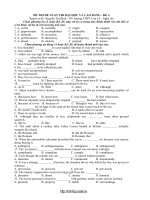- Trang chủ >>
- Đề thi >>
- Đề thi lớp 2
tieng anh 8
Bạn đang xem bản rút gọn của tài liệu. Xem và tải ngay bản đầy đủ của tài liệu tại đây (69.17 KB, 3 trang )
READING COMPREHENSION:
I.Read the passage and decide TRUE, FALSE or NOT GIVEN:
CHILIES
Chilies originate in South America and have been eaten for at least 9,500 years. Organised
cultivation began around 5,400 BC. Christopher Columbus was the first European to encounter
chilies, when he landed on the island of Hispaniola in 1492. He thought it was a type of pepper
and called it the “red pepper”, a name still used today. After their introduction to Europe they
were an immediate sensation and were quickly incorporated into the diet. From there they spread
to Africa, India and East Asia.
The reason for the chili’s “hotness” lies in a chemical called Capsaisin. Capsaisin causes
temporary irritation to the trigeminal cells, which are the pain receptors in the mouth, nose and
throat. After the pain messages are transmitted to the brain, endorphins, natural pain killers, are
released and these not only kill the pain but give the chili eater a short lived natural high. Other
side effects include: an increased heart rate, a running nose and increased salivation and sweating,
which can have a cooling effect in hot climates.
The reason for the presence of Capsaisin is thought to be to deter animals from eating the fruit.
Only mammals feel the burning effects; birds feel nothing. As birds are a better method of
distributing the seeds, which pass intact through their guts, Capsaisin would seem to be a result of
natural selection.
The smaller chilies tend to be the hottest. This may reflect the fact that they tend to grow closer
to the ground and are therefore more vulnerable to animals. The heat of a chili is measured on the
Scoville scale. The hottest types such as the Habenero and the Scotch Bonnet rate between
100,000 and 300,000, the world famous Tabasco sauceÒ rates at 15,000 to 30,000, about the
same as the Thai prik khee nu, while the popular Jalapeno is between 5,000 and 15,000.
Powdered chili is 500 to 1,000 and the mild capsicins and paprikas can range between 100 and 0.
----1.Chilies became popular as soon as they were brought into Europe.
_____________
2.Capsaisin causes significant damage to the mouth.
_____________
3.Chilies can be part of a birds diet.
_____________
4.All large chilies grow high off the ground.
_____________
5.People breed chilies for their heat.
_____________
II.Read the passage and decide TRUE, FALSE or NOT GIVEN:
The pyramid blocks were hewn from quarries using stone and copper tools. There are examples
of each stage of block extraction at existing ancient quarries. Granite was quarried using
pounding stones of dolerite, some of which have been found laying about the quarries. The blocks
were transported to the pyramid site from remote quarries using barges, and from local quarries
using wooden sleds. The Egyptians did not use the wheel during the Pyramid Age, an invention
that would have been of limited used on softer ground under heavy loads. The sleds were dragged
manually, sometimes with the help of beasts of burden, over smoothed roads. Some of the
existing pathways were equipped with transverse wooden beams to lend support to the sled. A
lubricant may have been poured upon the road to reduce friction.
----6.The wheel was invented during the Pyramid Age, even thought it wasn’t used. _____________
7.Sleds were dragged by animals, not humans.
_____________
8.It is possible that Ancient Egyptians could have lubricated their roads to aid transporttaion.
_____________
III.Fill ONE word that fits the best to each blank to make a suitable passage:
As a scientist working in Antarctica, I spend most of (9)_____ time in the lab studying ice. I am
trying to find out the age of Antarctic ice. All we know for certain is that it is the oldest ice
(10)_____ the world. The more we understand it, the more we will understand the
(11)__________ weather of the Earth. Today, as with an increasing number of days, I had to
leave my work to greet a group of tourists who (12)_____ taking a vacation in this continent of
ice. And even though I can appreciate their desire to experience this vast and beautiful landscape,
I feel Antarctica should be closed (13)_____ tourists.
IV.Fill ONE word that fits the best to each blank to make a suitable passage:
Makiko is training to be a geisha. Not (14)_____ girls want to be a geisha in Japan today.
Makiko’s parents want her to go to university, study medicine and become a doctor. But
Makiko’s grandfather (15)_____ for her training and bought the kimonos she needed. It’s very
expensive to become a geisha. You have to have a different kimono for each month of the year,
and today a kimono costs three million yen, that’s (16)_____ $30.000.
It’s a hard life for a trainee geisha. She has to leave her family and (17)_____ to a special
boarding house called a ‘maiko house’. Here, she has (18)_____ learn traditional Japanese arts
such as (19)__________ instruments, performing the tea ceremony, arranging flowers, singing
and dancing. She has to take many difficult tests and exams. Only the (20)_____ will pass
everything and become geishas many years later.
V.Choose the best option A, B, C or D for each blank:
The greenhouse effect is the process by (21)_____ absorption and emission of infrared radiation
by gases in the atmosphere warm the planet's lower atmosphere and surface. It was (22)_____ by
Joseph Fourier in 1824 and was first investigated quantitatively by Svante Arrhenius in 1896.
Naturally occurring greenhouse gases have a mean warming effect of about 33°C (59°F). But
human (23)_____ since the Industrial Revolution has increased the amount of greenhouse gases
in the atmosphere, leading to increased concentrations of CO2 and methane. The concentrations
of CO2 and methane have increased by 36% and 148% respectively (24)_____ 1750. These
levels are much higher than at any time during the last 650,000 years. Over the last three decades
of the 20th century, GDP (Gross Domestic Product) per capita and (25)_____ growth were the
main drivers of increases in greenhouse gas emissions. CO2 emissions are continuing to rise due
to the burning of fossil fuels and land-use change.
21. A. where
B. which
C. how
D. this
22. A. proposed
B. seen
C. thought
D. invented
23. A. activity
B. life
C. personality
D. time
24. A. in
B. on
C. for
D. since
25. A. populate
B. population
C. populous
D. populousness
- THE END -
ANSWER:
I.
1.True
2. False
3. True
4. Not given
5. Not given
II.
6. Not given
7. False
8. True
III.
9. my
10. in
11. changing
12. were
13. to
IV.
14. many
15. paid
16. about
17. move
18. has
19. playing
20. best
V.
21. B
22. A
23. A
24. D
25. B









